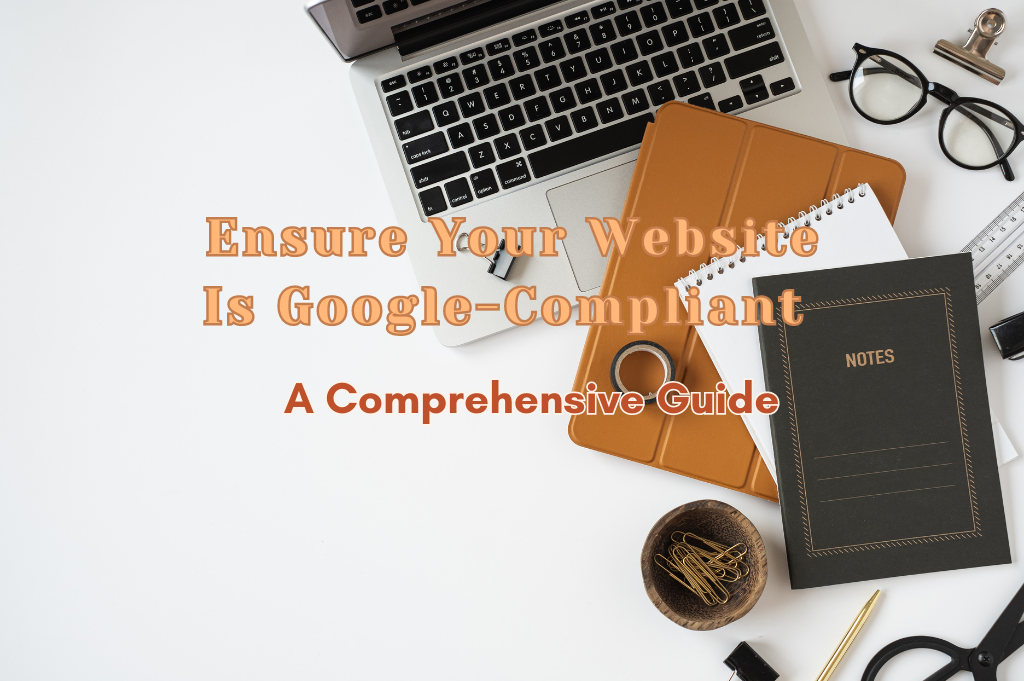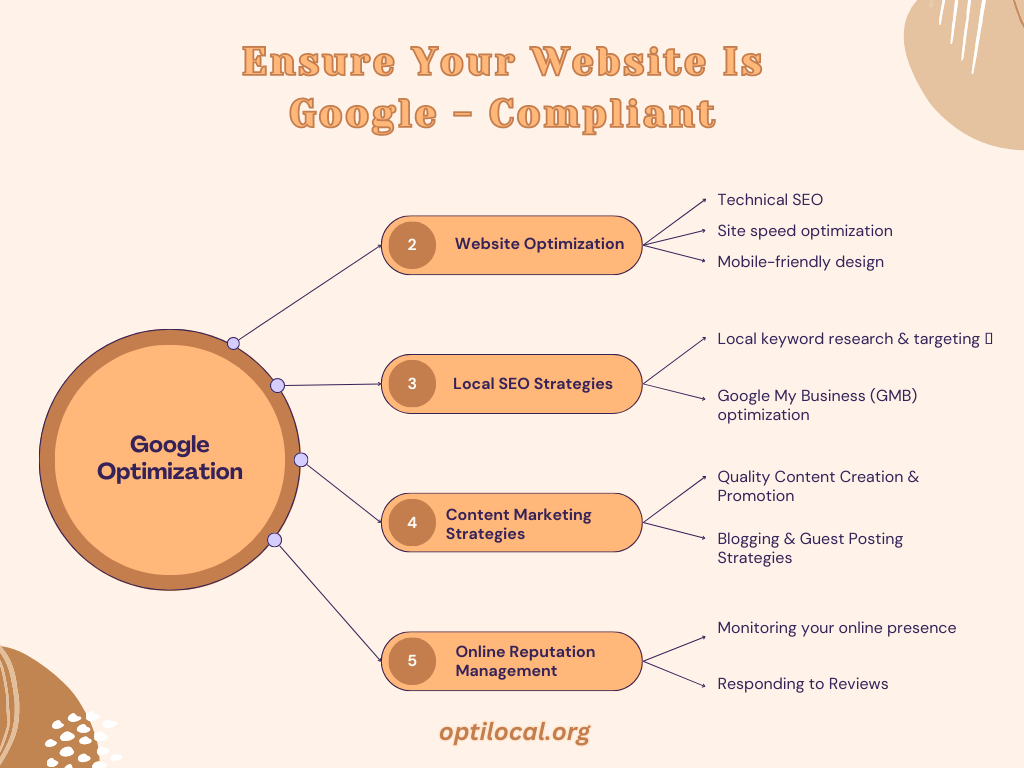Do you want to ensure that your website is in full compliance with Google standards? A comprehensive approach to local marketing should be taken to maximize your website’s potential and ensure it is compliant with Google standards.
There are a variety of steps you must take for your business site to reach its maximum potential.
This blog post will discuss these methods by keeping Google standards in mind.
Let’s start

More Resources :
Website Optimization
To ensure that your website is in full compliance with Google standards. Website optimization is a critical element of any successful digital marketing strategy.
Optimizing your website ensures users have an optimal experience and can help you reach more potential customers.it’s essential to optimize the technical aspects of your site. such as

Local SEO Strategies
Businesses aiming to create a digital presence and connect with their local consumers should use local SEO tactics. The two primary components of a successful local SEO strategy are:
It involves researching relevant keywords related to the business’s services or products and geographical location. By incorporating these location-specific keywords into various content pieces, search engines can more accurately determine the services and products offered by the business as well as its geographical area.
It is another important part of any effective local SEO strategy. GMB allows businesses to create a profile with information about their hours of operation, contact details, photos/videos, customer reviews, etc., which can then be displayed prominently in Google’s search results when users search for related terms. Ensuring potential customers can quickly access the necessary information to purchase is essential for GMB optimization.
Content Marketing Strategies
Content marketing is a powerful means for local companies to expand their reach and draw in new patrons. These strategies are essential for any business to ensure its website is optimized and visible online. OptiLocal offers comprehensive strategies that help businesses create, promote, and engage with quality content to boost their online presence.
Quality content creation is essential for any successful content marketing strategy. OptiLocal helps clients develop high-quality, engaging content that resonates with target audiences and drives website traffic. In addition, we offer advice on the most effective ways to disseminate the generated content through various channels, such as social media, email campaigns, and other digital outlets.
Blogging can effectively generate organic search engine traffic by providing relevant information about products or services a business offers. Additionally, guest posting on other websites provides an opportunity to establish credibility in the industry while increasing brand awareness through backlinks from authoritative sites. OptiLocal assists clients in developing blog topics and outlines as well as identifying potential opportunities for guest posting on relevant websites with high domain authority scores.
Online Reputation Management Tactics
Online reputation management is critical to any local business’s digital marketing strategy. Maintaining a favorable online image is critical for any business wanting to establish and safeguard its brand identity. It requires the following elements:
Monitoring your online presence regularly helps you avoid potential issues before they become bigger problems. This means checking for mentions on social media platforms, reviewing comments on blog posts or articles related to your business, and searching for customer feedback in online forums. By staying vigilant about what people say about your brand, you can identify areas needing improvement and respond promptly if needed.
Responding to reviews quickly and professionally is essential when managing your online reputation. If someone expresses dissatisfaction with your business, take the time to apologize or provide an appropriate explanation to demonstrate that you are dedicated to ensuring a positive customer experience. Show your customers you are invested in their satisfaction by promptly and thoughtfully addressing any issues they may have had with your business.
leveraging positive reviews is key to building an excellent online reputation – especially since most consumers read at least 10 reviews before purchasing from a local business. Encourage customers who have had good experiences with your company by asking them for feedback via email surveys or social media posts; this allows them to share their thoughts publicly, which can help attract more potential customers over time.
Structured Data Markup Implementation
Structured data markup implementation is an essential part of creating a website that meets legal requirements, compliance requirements, and user needs. It helps ensure content is accessible to all users regardless of their abilities or disabilities. Structured data markup can also help with SEO rankings and online visibility.
When implementing structured data markup, it’s important to consider the various laws related to digital accessibility such as the Americans with Disabilities Act (ADA) and Web Content Accessibility Guidelines (WCAG). Additionally, you should be aware of privacy laws like the California Online Privacy Protection Act (CalOPPA) and General Data Protection Regulation (GDPR). These regulations require websites to provide information about cookie policies, privacy policies, intellectual property rights protection measures, security measures against copyright infringement, etc. Adherence to these regulations could lead to serious consequences.
It’s also important to remember that structured data markups are not just limited to commercial websites but can also be used on blogs or other types of sites. For example, you can use microdata tags on blog posts, making it easier for search engines like Google and Bing to index them correctly. Hence, they appear in relevant searches more often than if no structured data was tagged. You can even create custom tags specific to your site if needed, which will further improve its visibility online.
Image Optimization Techniques
Image optimization is also an important part of any local marketing strategy. By optimizing images for the web, businesses can ensure that their content looks great on all devices and increases visibility in search engine results pages (SERPs). Several techniques can be used to optimize images for local SEO purposes.
When it comes to image optimization, size matters, and large files take longer to load, which can negatively impact user experience and SEO rankings. To improve performance, resizing and compressing images before uploading them onto websites or blogs is important. Image editing applications like Adobe Photoshop or GIMP provide an effortless way to modify the size of a picture while maintaining its quality. Compression tools like TinyJPG or JPEGmini can also help reduce file sizes without compromising visual appeal or clarity.
In addition to resizing and compressing images, businesses should add descriptive alt text and filenames when possible. This helps search engines understand what the image is about, improving visibility in SERPs and ensuring that people with visual impairments know what they’re looking at when browsing a website or blog post. When creating alt text descriptions, use keywords related to your business but avoid keyword stuffing as this could result in penalties from Google’s algorithm updates like Panda or Penguin.
The format of an image to be employed is contingent on the purpose for which it will be utilized, such as, for example, in social media posts or email campaigns. For example, GIFs work well for animations, while PNG files are better suited for logos because they retain transparency when needed. JPEGs offer superior compression rates compared with other formats but come at the cost of some quality loss over time depending on how often they are compressed and resized during upload processes. Choosing the right format based on your needs will help keep page loading times down while simultaneously delivering high-quality visuals across multiple platforms.
Link Building Strategies
Link building is an essential part of any local SEO strategy. Link construction is necessary for attaining greater search engine rankings for applicable keywords by increasing a website’s visibility and prestige. Link building involves creating high-quality backlinks from other websites that are related to yours. Link creation can be achieved through various approaches, such as authoring blog posts on other sites, circulating content, registering with directories, utilizing social media platforms for promotion, and leveraging influencers.
Regarding link building for local SEO purposes, getting links from sites with geographical relevance or target audience within your area is important. For example, suppose you own a restaurant in Chicago. In that case, you should seek links from food blogs or websites based out of Chicago or catering specifically to the city’s residents. Reaching out to nearby businesses you have a relationship with (e.g., suppliers) and inquiring if they would be willing to provide a link on their blog or web page about local vendors/suppliers could also benefit your local SEO efforts.
Remember traditional PR tactics such as press releases – these can be used online (via digital publications) and offline through newspapers and magazines. Remember to include valuable information when submitting press releases to make them stand out above others competing for attention.
FAQs about How to Ensure Your Website is compliant with Google Standards?
Conclusion
For full compliance with Google, a mix of optimization approaches can help improve the visibility of your business on search engine results pages. With these methods in place, you can maximize your reach while ensuring complete adherence to Google’s guidelines.
Take your website to the next level with OptiLocal‘s comprehensive services. Our experienced team will ensure that your site fully complies with Google standards, so you can focus on what matters most – growing your business.

